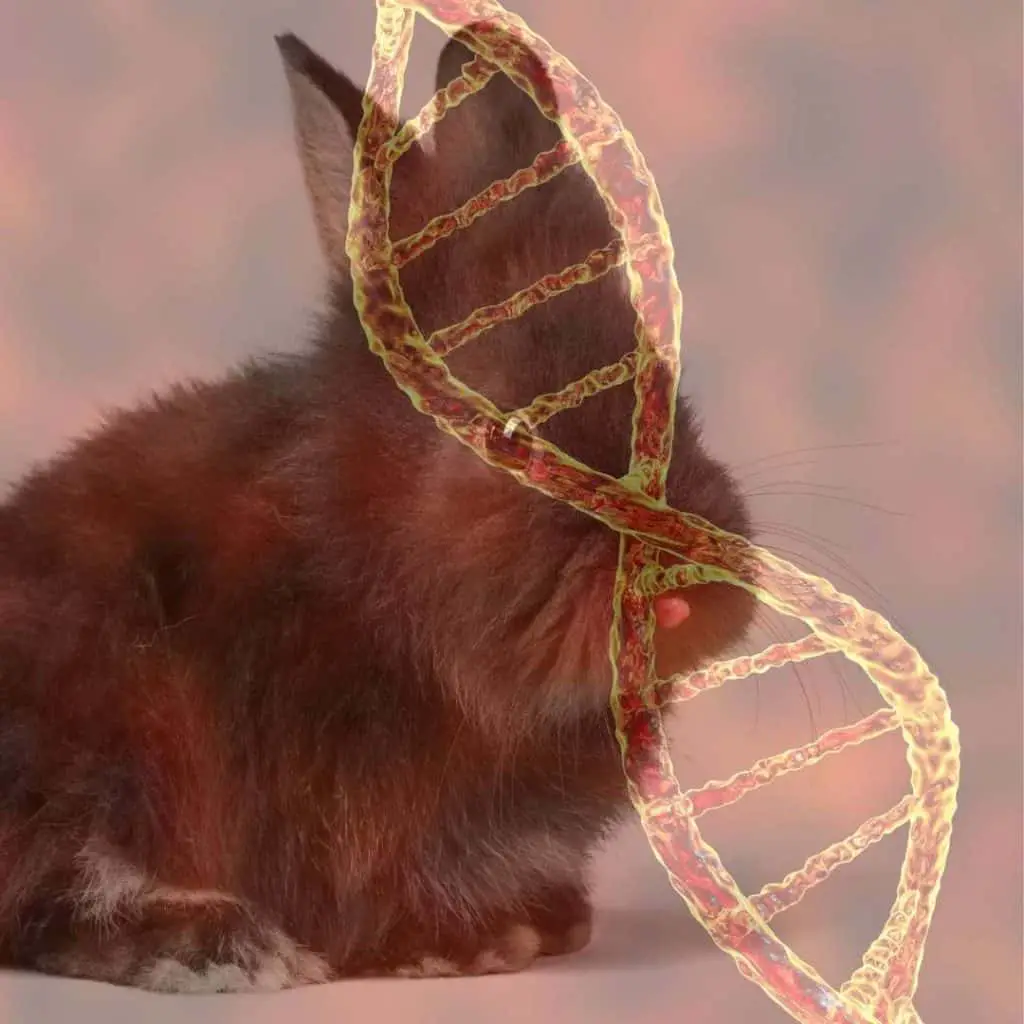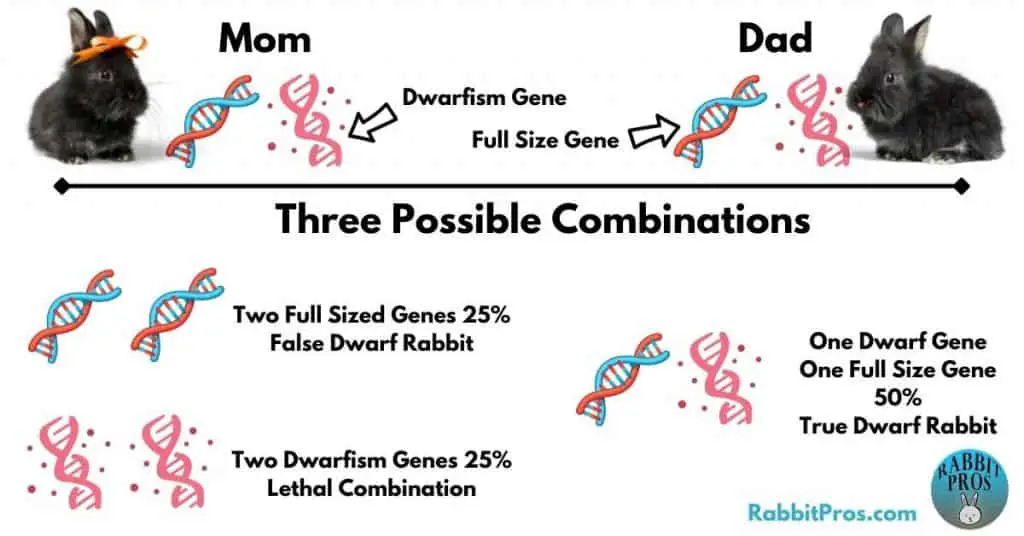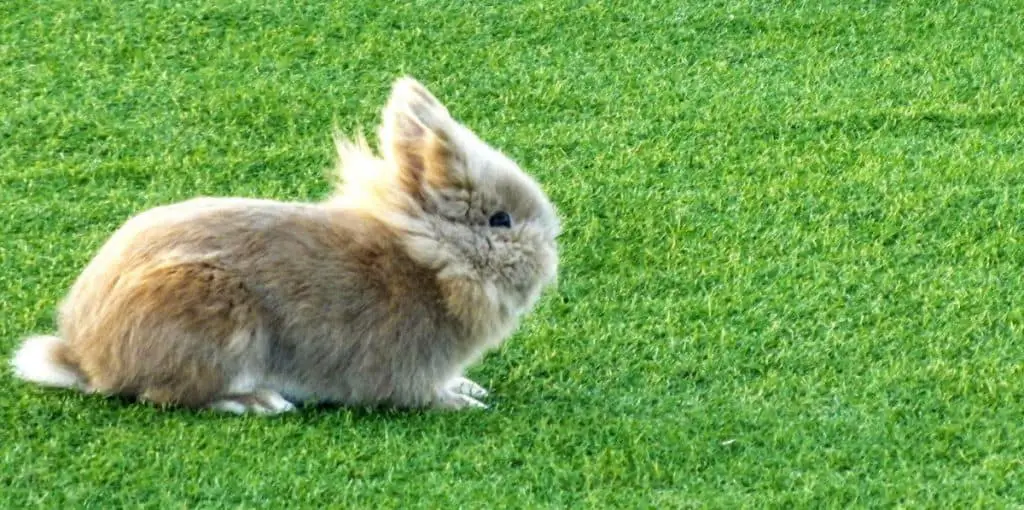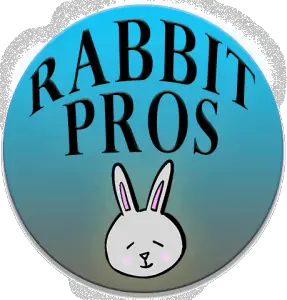Disclosure: We may earn money or products from the companies mentioned in this post.
Dwarf rabbits make up perhaps the most popular subgroup of pet rabbits, but do you really know what makes a dwarf bunny a ‘dwarf’? My team did all the research and in this article, you’re going to complete the “Dwarf Rabbits 101” course.
Dwarf Rabbits are affected by the genetic mutation caused by Dwarfism. A true Dwarf Rabbit breed contains a single dwarfism gene which causes these breeds to exhibit the traits and abnormalities that are commonly found for those that have the dwarfism gene.
The Dwarf Rabbit genetic mutation is believed to be caused by the deletion of the HMGA2 gene. This includes pituitary dwarfism. Pituitary Dwarfism is characterized by short stature, delayed dentition, and delayed skeletal mutation (Murray et al, 2000)
For other pets, dwarfism may be perceived as a flaw. However, this trait has not been a hindrance to the popularity of Dwarf Rabbit breeds. Dwarf rabbit breeds have garnered tons of followers that stand behind the merits of this breed.
This article will not serve to convince you nor to discourage you about dwarf rabbits. This is written to educate in the hopes that that right information will help you make a more informed decision.

What Causes A Dwarf Rabbit
Apologies for the possible onslaught of very scientific terms but I will try my best to give you a simplified version of the main causes of dwarfism in rabbit breeds. The information for this section is taken from the very meticulous thesis by Dao Hu titled “Identification and Analysis of the Dwarf Mutation in Domestic Rabbits”
The first study of dwarfism in rabbits was published in 1934 by Greene, Hu, and Brown. Through the magic of the internet, we can still read their article titled “A Lethal Dwarf Mutation in the Rabbit with Stigmata of Endocrine Abnormality“.
In their study, they found that carriers of the dwarfism gene are usually a third smaller than their littermates that do not have the gene. The carriers of the gene also are characterized by smaller compact bodies, short ears, and heads that are disproportionately larger than their bodies.
The mutation that causes dwarfism in rabbits is a single recessive gene found in Chromosome 4. This mutation causes the rabbit (or any other animal) to be smaller than other rabbits of the same breed and to exhibit traits of dwarfism, which includes a smaller body, shorter ears, and a relatively larger and blockier head.
It is important to note here the word single. A single dwarfism gene in rabbits is enough for it to manifest the dwarfism traits. However, while one dwarfism gene creates the cute bunnies we all love, a second dwarfism gene creates a non-viable rabbit that is either stillborn or dies shortly after birth.
To understand how a rabbit could get two of the dwarfism genes, we need to start by gaining a basic understanding of how genes work.
Rabbits (and all other living things) have two copies of each trait gene. In the case of true dwarf rabbits, their ‘size gene’ has one dwarfism gene and one full-size gene. (see the image below).
When these true dwarf rabbits are bred together, their offspring gets one copy of their size gene from their mom and the other from their dad. Which of the genes is passed on to each offspring is entirely random, which means that there are three potential size gene combinations that each baby will inherit:
- Dwarf/Full-Sized – True Dwarf Rabbit
- Full-Sized/Full-Sized – False Dwarf Rabbit
- Dwarf/Dwarf – Non-Viable Rabbit

Not every bunny born in a Dwarf Rabbit Litter will be a True Dwarf Rabbit. Within every litter of “purebred” dwarf rabbits, there will likely be True Dwarf Babies, False Dwarf Babies, And Non-Viable Babies.
The True Dwarf Rabbits are the most sought after, and often go on to be show rabbits or breeding stock. The Falso Dwarf Rabbits look nearly identical to the True Dwarf Rabbits, but their proportions are not ideal for the breed and they are a little larger. These bunnies are usually sold as pet rabbits.
The difference between a True Dwarf Rabbit and a False Dwarf Rabbit is that the True Dwarf bunny has the genetic mutation that causes dwarfism, and the False Dwarf Bunny does not. True and false dwarf bunnies look very similar, but the false dwarf is slightly larger and not as compact in build.
Pros and Cons Of Dwarf Rabbits
What’s an everything you need to know article without giving you the advantages and disadvantages of owning a dwarf rabbit?
Rabbits are generally quiet and sweet-tempered, they rarely bite or scratch, and even if they do it also rarely gets infected. However, not everything is sunshine and rainbows, owning a pet rabbit comes with some difficulties and compromises.
Here I’ve listed down the top pros and cons of specifically owning a dwarf rabbit. If you want to learn more about owning any kind of pet rabbit, you need to check out my Pros and Cons Of Owning A Pet Rabbit article.
Cuteness Galore – Advantage
This is a no-brainer actually, bunnies are the cutest and for some people having them fit in the palm of your hands just boosts the cuteness factor to a million. Imagine those Pinterest photos that you see of dogs in teacups but instead of dogs replace them with rabbits, cute right?
I always say that Dwarf rabbits are like the Peter Pan of the rabbit world, they’re forever stuck in Neverland, their features never change. The baby-faced rabbit that you get from day one will always retain that baby face facade until day 500.
Space Saver – Advantage
Healthy and happy rabbits need space to run around and exercise.
There has been an increasing clamor these days to uncage rabbits and let them roam free. Of course, this is mainly for indoor rabbits and dwarf rabbits are anything but outdoorsy.
Because of their small size, letting them roam free would not be such a hassle because they don’t take too much space as one of the giant rabbit breeds such as the Continental Rabbit.
And even if you plan to cage them for some hours in the day, a dwarf rabbit hutch would be much smaller than the usual hutch needed for a regular-sized rabbit.
Dwarfs are perfect for apartment living. If trained well, they will thrive and bond with their owner.
Cost-efficient (Food and Grooming) – Advantage
A smaller rabbit not only saves space but also saves on food and grooming.
Know that rabbits have extremely sensitive tummies. Their health is closely related to their gut health so owners need to provide quality food for their rabbits.
A healthy rabbit diet is composed of 80% quality hay and leafy greens. Of course, bigger rabbits would entail more hay and leafy greens, having a small mouth to feed will cost you less than having a gigantic rabbit breed.
Grooming is also easier with dwarf rabbit breeds. Although they need to be trimmed and groomed like their bigger cousins, the amount of surface area that you need to comb every other day makes for a stress and hassle-free grooming experience.
Skittish And Nervous – Disadvantage
Rabbits are prey animals, they don’t like sudden and loud noises. The smaller the size of rabbits there is also an increased tendency for them to be more skittish and nervous. This means that your rabbit may tend to be more aloof at first.
Do not worry though, it only takes patience and time and rabbits will find themselves comfortable in your presence.
Make sure that your dwarf rabbits are allowed time in the day for them to explore your home. If you try picking up your rabbit and you find that they don’t like it, then put them down gently.
You must keep your rabbit comfortable at all times. Bonding with dwarf rabbits will take many baby steps but the experience will be rewarding.
Of course, this also does not mean that this is true for all rabbits. Some rabbits can be skittish, some can be active and curious. There is no definitive hard rule and each rabbit has a personality different from another.
Fragile Bunnies – Disadvantage
Temperaments might be different from one dwarf rabbit to the next but one thing is constant, they’re small bunnies and they need to be handled as fragile animals.
Dwarf rabbit breeds have compact small bodies and bones. You need to be careful to not drop any pet rabbit, but it’s even more important with small bunnies like the dwarf rabbit breeds.
Children should be supervised when playing with dwarf bunnies and proper handling should be practiced and taught to them. Other pets should also be supervised when they are not separated, dwarf bunnies are prone to injury so constant vigilance is needed for their safety.
Higher Infant Mortality – Disadvantage
If you read the section above where we walk through what causes dwarf rabbits, then you know that when breeding two true dwarf rabbits together, on average 1/4 of the babies will get the dwarfism gene from both parents, and these babies will either be stillborn or die shortly after birth.
This is a significantly higher infant mortality rate than found in non-dwarf rabbit breeds.
Some breeders avoid this by breeding one true dwarf rabbit (has the dwarfism gene) with a false dwarf rabbit (one that did not inherit the dwarfism gene but still has most of the traits of the breed). With this combination, the breeder will get no genetic stillbirths, but will also have more false dwarf babies.

List Of 15 Dwarf Rabbit Breeds
I’ve covered many of the dwarf breeds in my Tiny Bunnies article, but not all of them.
My goal here was to create a comprehensive list of the dwarf rabbit breeds. Now, I’m including a few dwarf breeds on this list that are going to be a little controversial.
There are two ways to breed very small rabbits and you need to understand those before I explain my controversial inclusions on this list.
The first way to create a small bunny breed is to selectively breed for small size by just choosing the smallest rabbits in each successive generation as you try to produce the smallest possible bunny through this selective breeding. Rabbits produced this way are normally referred to as “Mini” rabbit breeds.
The second way to create a small bunny breed is to introduce the dwarfism breed which creates a dwarf rabbit.
However, many times breeders of ‘mini’ breeds take the shortcut of introducing the dwarfism breed which jumps starts their journey to develop tiny rabbits. It works too, but that dwarfism gene tends to just hang out undetected in that mini breed because the only easy way to detect it is to breed that rabbit with another rabbit that has the dwarfism gene. When babies from those two rabbits are peanuts (non-viable babies with dwarfism traits) you know both parents carried the dwarfism gene.
Many breeders of some of these ‘mini’ breeds would passionately tell you that their breed isn’t a dwarf breed. However, many of the rabbits in these mini breeds do have a hidden dwarfism gene. The most common mini rabbits with dwarfism genres are the Britannia Petite Rabbit and the Polish Rabbit.
- American Fuzzy Lop rabbit
- Britannia Petite Rabbit
- Columbia Basin Pygmy Rabbit
- Dutch Dwarf
- Dwarf Hotot
- Dwarf Rex rabbit
- Holland Lop Rabbit
- Jersery Wooly Rabbit:
- Lionhead Rabbit
- Mini Lop Rabbit
- Mini Satin Rabbit
- Miniature Cashmere Lop Rabbit
- Netherland Dwarf Rabbit
- Polish Rabbit
- Teddy Dwarf Rabbit
P.S If I overlooked another dwarf rabbit breed, please send me an email and set the record straight.
Cross Breeding Dwarf Rabbits
Dwarf rabbits can easily be crossbred but you need to be aware that if you breed two rabbits that both have the dwarfism gene (regardless of each rabbit’s breed), there is a chance that some of the babies will inherit two dwarfism genes which result in a stillborn kit or one that dies soon after birth.
Breeding Dwarf Rabbit Breeds
It isn’t any harder to breed Dwarf Rabbit breeds than any other breed of rabbit, however, you need to be aware that the stillborn rate is much higher with dwarf breeds. Statistically, 25% of babies born to two true dwarf rabbits will have inherited two copies of the dwarfism gene which makes that baby non-viable.
Here is a link to an article that walks you through rabbit pregnancy.
How To Tell If Your Rabbit Is A Dwarf
For the technology-savvy person, genome sequencing will be the perfect way to tell if your rabbit breed is a dwarf. But if you’re like me and you don’t have genome sequencing equipment handy, then DNA testing should also work…but who am I kidding? Normal people don’t have access to these technologies and with false rabbits being a thing, how can you be sure that your rabbit is indeed a dwarf?
You can sometimes visually inspect your rabbit to tell if it is a true dwarf rabbit or a false dwarf rabbit. It’s easier to tell if you have a known dwarf of the same breed to compare with. False dwarfs are slightly larger, their ears slightly longer, and their bodies are less compact with more a lanky appearance.
You can tell if your rabbit is a true dwarf by breeding it with a knowing true dwarf. If both parents carry the dwarfism gene, then 25% of the babies will be peanuts which means that they will be really small, exhibit extreme traits of dwarfism, and be stillborn or die shortly after birth.
Dwarf Rabbits Size
Dwarf rabbits are the smallest rabbit breeds. In general, dwarf rabbits are about 1/3 the size of standard-sized rabbits, and 1/2 the size of mini rabbits.
| Standard Size | Mini | Dwarf | |
| Weight | 6 lbs | 4 to 6 lbs | 2 to 4 lbs |
| Body | Compact, semi arch, commercial, Full arch | Compact, semi arch, commercial, Full arch | Compact body |
| Face | Can be wedged-shaped or round but does not retain its neotenic features as it grows. | Can be wedged-shaped or round but does not retain its neotenic features as it grows. | The Head is bigger than its body with short ears and large eyes. Retains its neotenic features as it grows. |
Dwarf Rabbit Health Issues
Dwarf rabbits don’t have any more health issues than other rabbits, except for a higher stillbirth death rate caused by the semi-lethal dwarfism gene. As a matter of fact, smaller rabbits tend to have longer lifespans than larger rabbits, and as the smallest breeds dwarf rabbits live the longest.

I hope you learned everything you wanted to know about dwarf rabbits. If I messed something, be sure to join the Rabbit Pros email list and ask us your question there.
~Stacey
